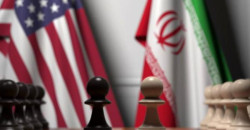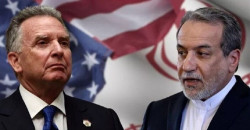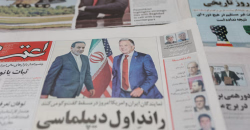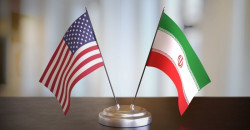In Muscat: a cautious dance of diplomacy between Iran and the US

Shafaq News/ In the hushed corridors of Muscat, where silence is a strategic language, a high-stakes diplomatic dance has resumed. Behind closed doors, Iran and the US are engaged in talks that could either defuse years of escalating tension or plunge the region into deeper crisis. The nuclear question, with all its familiar anxieties, is once again on the table.
Led by Iran’s seasoned diplomat Abbas Araghchi and President Donald Trump’s Middle East envoy Steve Witkoff, the two delegations never shared the same room. Instead, messages traveled between them through Omani Foreign Minister Badr al-Busaidi, Oman’s discreet and trusted broker.
The setup was symbolic: proximity without intimacy, dialogue without trust. And yet, the very fact that these talks occurred—after months of diplomatic inertia and rising regional tension—was, in itself, a fragile victory.
According to sources by Shafaq News, the discussions covered three primary issues: mechanisms to deescalate regional tensions, the possibility of prisoner exchanges, and the pursuit of a limited agreement that would ease US sanctions in exchange for Iran slowing the pace of its nuclear program.
Notably, the mood, described as “cordial” by Omani mediators, signaled a mutual desire to prevent further deterioration—even if both sides remained entrenched in their demands.
Iranian media was quick to frame the talks as purely nuclear in scope, pushing back against speculation that broader issues like regional militias or cyber operations were on the table. This was no surprise. Tehran, still wary of overpromising as it did in the run-up to the 2015 Joint Comprehensive Plan of Action (JCPOA), has learned to compartmentalize. Its official stance is clear: no threats, no distractions—just a “win-win” negotiation rooted in dignity.
For Washington, however, the agenda was more ambitious. Dr. Ali Aghwan, a political sciences professor at the University of Mosul, noted in a statement to Shafaq News that the US side demanded a return to uranium enrichment limits of 3.67%, a freeze on the development of ballistic missile systems such as Qiam-1 and Khorramshahr, and access for international nuclear inspectors.
“In return, Iran wants nothing less than the full rollback of oil, banking, and trade sanctions, legal guarantees that the US won't abandon the deal again—as it did in 2018—and an end to Israel’s military edge, particularly regarding weapons capable of striking Iranian soil.”
One side asks for technical rollbacks and transparency. The other seeks economic salvation and geopolitical protection. Yet beneath these hardened positions lies a sliver of possibility: both want out of the current impasse, even if for different reasons.
For Tehran, the economic pressure is unrelenting. Inflation, unemployment, and social unrest have gnawed at the legitimacy of the Islamic Republic, and even China—its most reliable partner in recent years—has shown signs of distancing itself from Iran’s more hardline impulses. The growing risk of internal instability, coupled with a desire to secure long-term energy contracts, gives the regime incentives to negotiate, though cautiously.
For the United States, the motivations are more complex. President Trump, back in the White House after a divisive election, is navigating a deeply polarized domestic landscape. His administration’s return to the Middle East peace file—marked by the recent normalization push involving Saudi Arabia and Israel—cannot afford an Iranian nuclear crisis on the sidelines. Moreover, a limited nuclear deal could be presented as a diplomatic win without the long-term political cost of a comprehensive treaty.
Both sides know the history. The JCPOA was signed in 2015, collapsed in 2018, and left behind a residue of bitterness. Since then, diplomacy has struggled to regain momentum. Talks in Vienna (2021–2022) faltered, the war in Gaza shifted global attention, and a new era of great power competition—with China and Russia emboldened—has made the Middle East feel less central to Washington’s strategic priorities.
But Muscat, with its quiet fountains and unassuming conference rooms, still holds symbolic power. Oman is one of the few actors that can speak to both Washington and Tehran without suspicion. Its role in facilitating the 2015 deal is well-remembered, and its neutral diplomacy remains a rare currency in a region defined by blocs and proxy wars.
As analyst Firas Elias noted, this round of talks revealed a “fundamental divergence” in negotiation tactics. The US pushed for a fast-track, all-encompassing solution, while Iran prefers a phased approach focused narrowly on the nuclear file. This asymmetry, while frustrating, could serve as a functional starting point. “Iran's strategy seems aimed at extracting incremental concessions, knowing that Trump’s window for a political win may close quickly,” he pointed out.
Iranian researcher Dr. Saeed Shavardi believed that both parties have agreed to continue discussions next week in Muscat, possibly with the addition of details related to easing sanctions and ensuring the peaceful nature of the nuclear program, characterizing the mood as one of “cautious optimism.”
While no grand announcement is expected in the near term, both sides are prepared to keep talking. Another round is already scheduled for next week, potentially in Europe—a neutral shift that suggests the conversation may slowly evolve beyond Muscat’s careful neutrality.
Outside the negotiation rooms, the world is watching—carefully and, at times, skeptically. The European troika (Germany, France, and the UK) welcomed the dialogue but reminded both parties that any deviation from nuclear limits could trigger the "snapback" mechanism, restoring UN sanctions. Their message was clear: diplomacy is welcome, but compliance is non-negotiable.
Regionally, the support has been warmer. Saudi Arabia praised Oman’s efforts and expressed hope that diplomacy could stabilize the region. The UAE and Jordan issued similar statements, emphasizing dialogue over escalation.
Egypt, grappling with its regional anxieties, called for an agreement that respects the interests of Gulf neighbors and reduces tensions—particularly in Gaza. I
raq, always vulnerable to the fallout of US-Iran tensions, also voiced hope for de-escalation.
Indeed, the regional context is vital. The Middle East of 2025 is not the same as it was in 2015. The Gaza crisis, ongoing since late 2023, has inflamed passions and altered alliances. The Saudi-Iran rapprochement of 2023 remains fragile. The oil markets, although relatively stable, are vulnerable to geopolitical shocks. And with global attention divided between Eastern Europe and the Pacific, no one wants the Persian Gulf to light up again.
In the words of an Omani diplomat involved in the talks, "The road is long, but it's better walked than ignored." And for now, walking—however slowly, however skeptically—is exactly what Iran and the United States have chosen to do.





